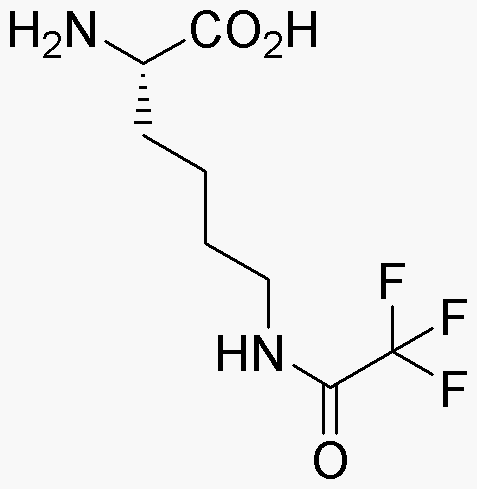Ne-Trifluoroacetyl-L-lysine is widely utilized in research focused on:
- Biochemical Research: This compound is used as a reagent in the synthesis of peptides and proteins, allowing researchers to study protein interactions and modifications.
- Drug Development: It serves as a building block in pharmaceutical chemistry, particularly in the design of new drugs targeting specific biological pathways, enhancing therapeutic efficacy.
- Diagnostic Applications: Its unique properties make it useful in developing diagnostic tools for diseases, helping in the identification of biomarkers in clinical settings.
- Material Science: The compound is explored for its potential in creating novel materials with specific properties, such as improved thermal stability and chemical resistance.
- Environmental Chemistry: It is studied for its role in understanding the behavior of fluorinated compounds in the environment, contributing to the development of safer chemical alternatives.
General Information
Properties
Safety and Regulations
Applications
Ne-Trifluoroacetyl-L-lysine is widely utilized in research focused on:
- Biochemical Research: This compound is used as a reagent in the synthesis of peptides and proteins, allowing researchers to study protein interactions and modifications.
- Drug Development: It serves as a building block in pharmaceutical chemistry, particularly in the design of new drugs targeting specific biological pathways, enhancing therapeutic efficacy.
- Diagnostic Applications: Its unique properties make it useful in developing diagnostic tools for diseases, helping in the identification of biomarkers in clinical settings.
- Material Science: The compound is explored for its potential in creating novel materials with specific properties, such as improved thermal stability and chemical resistance.
- Environmental Chemistry: It is studied for its role in understanding the behavior of fluorinated compounds in the environment, contributing to the development of safer chemical alternatives.
Documents
Safety Data Sheets (SDS)
The SDS provides comprehensive safety information on handling, storage, and disposal of the product.
Product Specification (PS)
The PS provides a comprehensive breakdown of the product’s properties, including chemical composition, physical state, purity, and storage requirements. It also details acceptable quality ranges and the product's intended applications.
Certificates of Analysis (COA)
Search for Certificates of Analysis (COA) by entering the products Lot Number. Lot and Batch Numbers can be found on a product’s label following the words ‘Lot’ or ‘Batch’.
*Catalog Number
*Lot Number
Certificates Of Origin (COO)
This COO confirms the country where the product was manufactured, and also details the materials and components used in it and whether it is derived from natural, synthetic, or other specific sources. This certificate may be required for customs, trade, and regulatory compliance.
*Catalog Number
*Lot Number
Safety Data Sheets (SDS)
The SDS provides comprehensive safety information on handling, storage, and disposal of the product.
DownloadProduct Specification (PS)
The PS provides a comprehensive breakdown of the product’s properties, including chemical composition, physical state, purity, and storage requirements. It also details acceptable quality ranges and the product's intended applications.
DownloadCertificates of Analysis (COA)
Search for Certificates of Analysis (COA) by entering the products Lot Number. Lot and Batch Numbers can be found on a product’s label following the words ‘Lot’ or ‘Batch’.
*Catalog Number
*Lot Number
Certificates Of Origin (COO)
This COO confirms the country where the product was manufactured, and also details the materials and components used in it and whether it is derived from natural, synthetic, or other specific sources. This certificate may be required for customs, trade, and regulatory compliance.


